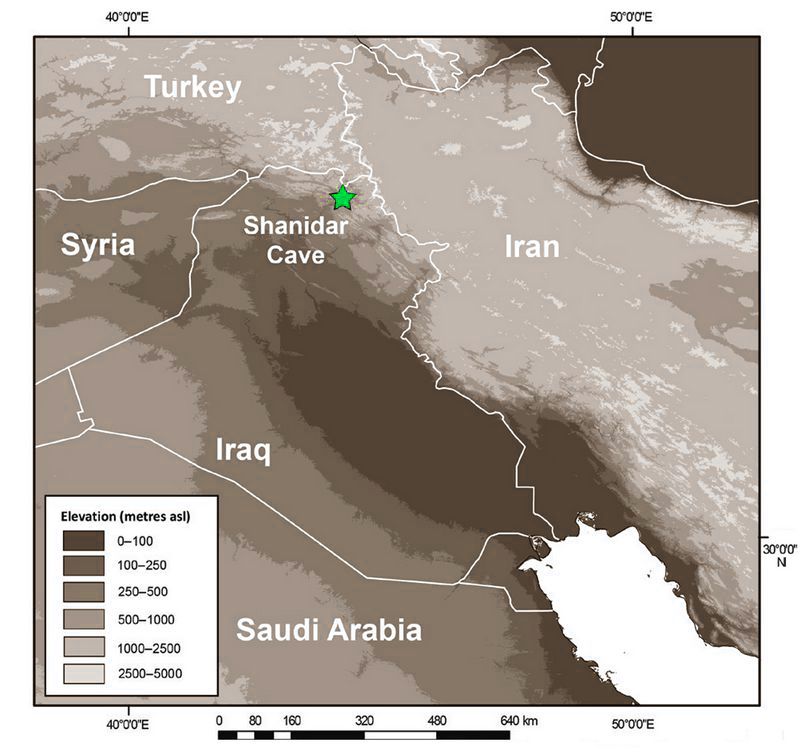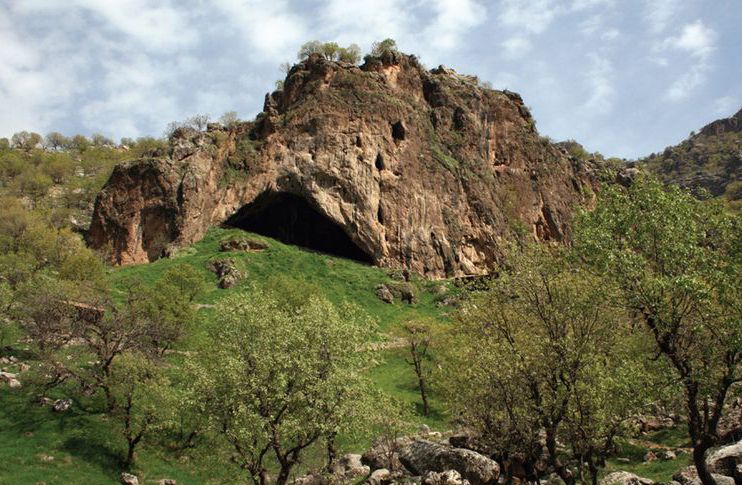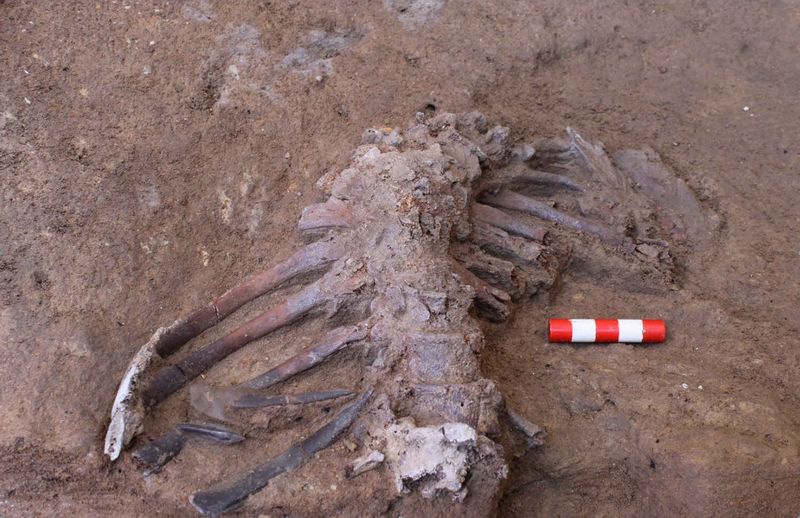Rust Family Foundation: Archaeology Grants Program
Investigating Neanderthal Notions of Death and its Aftermath
at Shanidar Cave, Iraqi Kurdistan
Principal Investigator: Graeme Barker
Disney Professor of Archaeology Emeritus and Senior Fellow
McDonald Institute for Archaeological Research,
University of Cambridge
Shanidar Cave in the Zagros mountains of Iraqi Kurdistan (figs.1,2) is an iconic Palaeolithic site as a result of the discoveries made by Ralph Solecki in his 1
 951-1960 excavations: a long sequence of Middle Palaeolithic,
Upper Palaeolithic and Epipalaeolithic occupation; the skeletal remains
of 10 Neanderthals; and a Proto-Neolithic cemetery. Solecki’s
conclusions that some Neanderthals had been killed in rock falls but
that others had been buried with formal funerary rites have been much
debated by scholars ever since, and remain at the heart of the ongoing
debate about the behavioural similarities and differences between
Neanderthals and Modern Humans.
951-1960 excavations: a long sequence of Middle Palaeolithic,
Upper Palaeolithic and Epipalaeolithic occupation; the skeletal remains
of 10 Neanderthals; and a Proto-Neolithic cemetery. Solecki’s
conclusions that some Neanderthals had been killed in rock falls but
that others had been buried with formal funerary rites have been much
debated by scholars ever since, and remain at the heart of the ongoing
debate about the behavioural similarities and differences between
Neanderthals and Modern Humans. Fig.1: Location of Shanidar Cave.
 .
.Fig.2: Shanidar Cave viewed from the south (image: Graeme Barker).
Previous Research in the region
The new excavations led by the PI began in 2015, with a particular focus on establishing a robust chronological and climatic framework for the Middle and Upper Palaeolithic occupations, including the Neanderthal burials, and on collecting evidence for the lifeways of the Neanderthals and Modern Humans using the cave.
An unexpected bonus was the discovery of further skeletal remains of Neanderthals, some of which could be shown definitely to be part of Solecki’s Shanidar 5 skeleton found at around 5 m below the surface and some of which appeared to be part of the unique cluster of individuals (Shanidar 4,6,8 and 9) found by Solecki at about 8 m depth that included the famous (and much disputed) ‘Flower Burial’ (Shanidar 4) that we have dated by the OSL (Optically Stimulated Luminescence) method to around 75,000 years ago.
2019 Funded Research Project (RFF-2019-98)
Goals:
The principal objective of the 2019 fieldwork was to investigate the Neanderthal skeletal remains observed in section in 2018 to lie below the badly crushed skull and part of the upper body of an adult Neanderthal that we consolidated and removed in September 2018, and to attempt in the process to establish if it was a deliberate burial.
Methodologies:
Most of the Neanderthal remains found by Solecki were located in the eastern extension of his 20 x 6 m trench, so the new excavations have concentrated on this area and the adjacent part of his main trench. Backfill that had accumulated during and after the Solecki excavations has been removed to expose the walls of his trench down to c.10 m depth.
Findings:
In 2019 excavations we were able to expose, consolidate and lift a relatively complete and articulated ribcage and thoracic spine, together with part of the left scapula (fig.3). Excavation confirmed that these and the bones recovered in 2018 belong to a single articulated adult skeleton. The lower part of the body, i.e. the hips, legs and feet, are missing and must have been removed in 1960 when Ralph Solecki lifted the adjacent Shanidar 4 ‘Flower Burial’ in a block of sediment.

.
Fig.3: Shanidar Cave, Iraqi Kurdistan: the thoracic spine and associated ribs of an adult Neanderthal exposed, consolidated and lifted in the 2019 field season. The crushed skull and upper body of this individual were excavated in 2018. After the removal of these bones, fragmentary remains of another individual were found at the top right of the image at a lower stratigraphic level. Scale: 5 cm (Image: Graeme Barker).
The new individual - the first articulated Neanderthal skeletal remains found anywhere in the Neanderthal realm for some 35 years - lay in a gully partly formed by water action but also enlarged and deepened on one side by human agency. It was also partially covered by a stone of non-local type that is separated from overlying rockfall by occupation sediments, so cannot be part of that rock fall. The field evidence points to the body having been deliberately placed and protected.
Sediment blocks being investigated for their micromorphology should further clarify the character and depositional environments of the sediments around the body. Some 8-10 cm below this individual we exposed but left in situ a scattering of disarticulated hand and wrist bones, some ribs, and a heavily worn adult tooth that derive from another individual. The accumulating evidence is that the Shanidar 4 cluster comprised a veritable ‘cemetery’ of closely placed bodies that is absolutely unique in Neanderthal archaeology.
Higher up the sequence we exposed a series of Neanderthal occupation layers interleaved with rock fall. We identified the remnants of a hearth in one of these layers that probably relates to similar hearths recorded in the 1960 excavations. Solecki describes these as lying immediately to the south of the Shanidar 3 human remains, giving confidence that we have identified the location of Shanidar 3 with reasonable precision and that the sediment samples we took for OSL dating will provide a robust indication of its age (likely around 55,000 years ago).
Future fieldwork
Looking forward, the interleaving of rockfall, small-scale occupation activity, and body placement provides a unique opportunity to use precision excavation techniques to investigate the timespan and sequence of body placement activities. What were the time gaps between human occupation activity and funerary activity in the cave? Did people engage in mortuary behaviour alongside using the cave as a subsistence base, or did the cave alternate in use between a place for the living and place for the dead? Whatever we discover about the relationship between the living and the dead in this extraordinary site has the potential to make a significant contribution to current understanding of the Neanderthal mind.
Laboratory work on the 2019 finds, brought to Cambridge for study along with the earlier finds of the same individual, is currently suspended because of the Coronavirus lockdown of the university, but will resume as soon as the laboratories are re-opened.
Publication:
A preliminary paper on the new Neandertal finds (Pomeroy et al. 2020) was published in the journal Antiquity in February 2020, achieving some of the largest press and media interest of any paper published by the journal.
References:
Barker, G., 2017. A Tale of Three Caves: Why Was Our Species So Sucessful at Colonising New Environments? Amsterdam: Stichting Nederlands Museum voor Anthropologie en Praehistorie.
Fiacconi, M., 2017. Cave Pollen Taphonomy in Kurdish Iraq. Liverpool John Moores University, unpublished PhD thesis.
Fiacconi, M., and C.O. Hunt, 2015. Pollen taphonomy at Shanidar Cave (Kurdish Iraq): an initial evaluation. Review of Palaeobotany and Palynology 223, 87–93.
Fiacconi, M., and C.O. Hunt, 2016. Palynology of surface sediments from caves in the Zagros Mountains (Kurdish Iraq): patterns and processes. Review of Palaeobotany and Palynology 239, 66–76.
Hunt, C. O., and M. Fiacconi, 2018. Pollen taphonomy of cave sediments: what does the pollen record in caves tell us about external environments and how do we assess its reliability? Quaternary International 485, 63-75.
Hunt, C.O., D.D. Gilbertson, E.A. Hill, and D. Simpson, 2015. Sedimentation, re-sedimentation and chronologies in archaeologically-important caves: problems and prospects. Journal of Archaeological Science 56, 109–116.
Hunt, C.O., E.A. Hill, T. Reynolds, D. Abdulmutalb, L. Farr, R. Lane, K. Szabó, and G. Barker, 2017. An incised shell object from Baradostian (Early Upper Palaeolithic) layers in Shanidar Cave, Iraqi Kurdistan. Journal of Archaeological Science Reports 14, 318–322.
Pomeroy, E., M. Mirazón Lahr, F. Crivellaro, L. Farr, T. Reynolds, C.O. Hunt, and G. Barker, 2017. Newly discovered Neanderthal remains from Shanidar Cave, Iraqi Kurdistan, and their attribution to Shanidar 5. Journal of Human Evolution 111, 102–118.
Pomeroy, E., P. Bennett, C.O. Hunt, T. Reynolds, L. Farr, M. Frouin, J. Holman, R. Lane, C. French, and G. Barker, 2020. New Neanderthal remains associated with the ‘flower burial’ at Shanidar Cave. Antiquity 94 (373), 11–26.
Reynolds, T., W. Boismier, L. Farr, C. Hunt, D. Abdulmutalb, and G. Barker, 2016. New investigations at Shanidar Cave, Iraqi Kurdistan, in The Archaeology of the Kurdistan Region of Iraq and Adjacent Regions, eds K. Kopanias and J. MacGinnis. Oxford: Archaeopress, 369–372.
Reynolds, T., L. Farr, E. Hill , C. Hunt, S. Jones , B. Gratuze, A. Nymark, D. Abdulmutalb, and G. Barker, 2018. Shanidar Cave and the Baradostian, a Zagros Aurignacian industry. l'Anthropologie 122: 737–748.
.
Recent Foundation grants: general Archaeology Grants Program w/map
Copyright © 2020 Rust Family Foundation